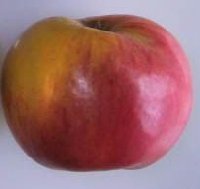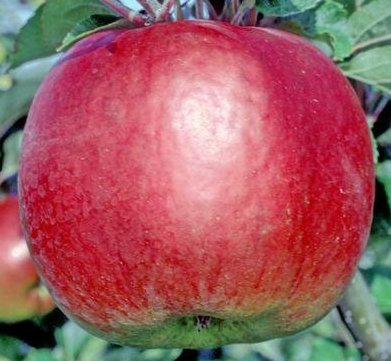PARENTAGE
One of the parents of Annie Elizabeth is known to be Blenheim Orange, the other parent is currently unknown. It was first identified by Samuel Greatorex in Leicestershire and dates back to 1857.
APPEARANCE, TASTE AND CHARACTERISTICS OF ANNIE ELIZABETH
Annie Elizabeth dates back to Victorian times when it was raised as a seedling by Harrison and Sons in Leicester. It is a top quality cooking apple with lots of sweetness to it. When cooked it retains its shape well making it ideal for use in tarts where its shape and taste can be appreciated.
The apples are normally ready for eating from late October to early November depending on which part of the UK you live in. The shaded side is predominantly a yellow colour with the sun side being a rich red colour. The apples are larger than average and the flesh is quite dense.
Cut through the skin and the fruit is clean, pure white. In common with many cookers that produce fruit late in the year Annie Elizabeth keeps extremely well, often to the end of March especially if stored cool.
It was grown commercially in the UK until the early 1930s when it ran out of favour. In 1869 it received a First Class Certificate from the RHS. Annie Elizabeth has attractive deep purple blossoms which are hardy to late frosts. This is an ideal apple tree which can easily withstand the cold and wet weather of Northern parts of the UK. It shows good resistance to canker, often a problem in cool and damp areas.
An Annie Elizabeth apple – side facing the sun
Some information from public sector information licensed under the Open Government Licence v2.0.
BUYING AN ANNIE ELIZABETH APPLE TREE
Annie Elizabeth is not one of those varieties which the supermarkets or diy stores sell cheap nor is it likely to be found in the mainstream garden centres. However it can easily be found online at a number of well-known suppliers.
SUMMARY CHARACTERISTICS OF ANNIE ELIZABETH
USE: Cooker
SKIN COLOUR / TEXTURE: Red and yellow skin
FLESH COLOUR: Crisp white
TASTE AND TEXTURE: Sweeter than most cooking apples, requires only a little additional sugar. Retains its shape well when cooked.
FRUIT SIZE: Larger than normal
SUITABILITY FOR CORDON / ESPALIER GROWTH: Yes
TREE SIZE: Average size depending on rootstock and conditions
REGULARITY OF CROPPING: Very regular
POLLINATION: Group 4. It is partially self-fertile and is not good at pollinating other
varieties (if it does at all). It will definitely need a suitable pollination partner.
AWARDS: RHS First Class Certificate
SPECIAL FEATURES: High sugar content and retains its texture and shape when cooked.
ANNIE ELIZABETH FLOWERING AND HARVEST TIMES:
The average flowering time (optimum time for pollination) and date when fruits are ripe in the UK for the Annie Elizabeth apple tree are set out below. If you have set your home town we can give you a more accurate estimate, if you have not set your home town (do it now by clicking here) the dates below will be the average for the UK.
Flowering and fruit picking dates vary according to the weather in any particular growing season so the above dates may well change slightly from one year to the next. The flowering date above is when the apple tree produces the maximum number of blossoms, it will also produce blossom, although less, a week or two either side of the date given.
ANNIE ELIZABETH POLLINATION
Annie Elizabeth is in pollination group 4, partially self-fertile but is not a good pollinator of other apple trees. We list below varieties which are suitable pollination partners.
- Arthur Turner – pollination group 3, self-sterile, cooker
- Bountiful – pollination group 3, self-sterile, cooker
- Braeburn – pollination group 4, self-fertile, eater
- Charles Ross – pollination group 3, partially self-fertile, cooker and eater
- Court of Wick – pollination group 3, self-sterile, eater and cooker
- Discovery – pollination group 3, self-sterile, eating and cider
- Dumelows Seedling – pollination group 4, self-sterile, cooker
- Ellisons Orange – pollination group 4, partially self-fertile, eater
- Emneth Early – pollination group 3, partially self-fertile, cooker
- Epicure – pollination group 3, self-fertile, eater
- Falstaff – pollination group 3, self-fertile, eater
- Fiesta – pollination group 3, partially self-fertile, eater
- Gala – pollination group 4, partially self-fertile, eater
- Golden Delicious – pollination group 4, partially self-fertile, eater and cooker
- Granny Smith – pollination group 3, self-fertile, eater and cooker
- Grenadier – pollination group 3, partially self-fertile, cooker
- Honeycrisp – pollination group 4, self-sterile, eater
- Howgate Wonder – pollination group 3, partially self-fertile, cooker and eater
- James Grieve – pollination group 3, partially self-fertile, cooker and eater
- Katy – pollination group 3, self-sterile, both
- Kidds Orange Red – pollination group 3, self-sterile, eater
- King of The Pippins – pollination group 4, partially self-fertile, eater and cooker
- Lanes Prince Albert – pollination group 4, self-sterile, cooking
- Laxtons Fortune – pollination group 3, partially self-fertile, eater
- Laxtons Superb – pollination group 4, partially self-fertile, eater
- Lord Derby – pollination group 4, self-sterile, cooker
- Merton Beauty – pollination group 5, self-sterile, eater
- Newton Wonder – pollination group 4, partially self-fertile, cooker
- Peasgoods Nonsuch – pollination group 3, partially self-fertile, cooker
- Rajka – pollination group 4, self-sterile, eater
- Red Falstaff – pollination group 3, partially self-fertile, eater
- Scrumptious – pollination group 3, self-fertile, eater
- Sops in Wine – pollination group 3, self-sterile, juicer
- Spartan – pollination group 3, self-fertile, eater
- Sunset – pollination group 3, self-fertile, eater
- Tydemans Late Orange – pollination group 4, self-sterile, eater
- Waltz – pollination group 3, self-sterile, eater
- Winston – pollination group 4, self-fertile, eater
- Worcester Pearmain – pollination group 3, partially self-fertile, eater
The full list of apple tree varieties which we have reviewed is listed below. Select any one of them and then click the “More Information” button to be taken to the in depth review:



Rootstocks and Size
Guide to Planting
Care Plan
Pruning Apple Trees
Harvest and Storage
Pests and Disease
Pollination Groups
ANNIE ELIZABETH APPLE TREE
By David Marks
If you want a quality cooking apple which retains its shape then look no further than Annie Elizabeth. Especially good for growing in cooler and wetter areas, it can survive anything that the British weather throws at it.
It does have a tendency to drop some its apples just before they are ripe but the overall crop from this tree is more than large enough to make up for this deficiency. Its other qualities include beautiful half red apples and in spring time masses of deep purple blossom.